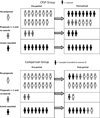Grant Success for Early-Career Faculty in Patient-Oriented Research: Difference-in-Differences Evaluation of an Interdisciplinary Mentored Research Training Program
- PMID: 27332867
- PMCID: PMC5177544
- DOI: 10.1097/ACM.0000000000001263
Grant Success for Early-Career Faculty in Patient-Oriented Research: Difference-in-Differences Evaluation of an Interdisciplinary Mentored Research Training Program
Abstract
Purpose: Since 2004, the Clinical Faculty Scholars Program (CFSP) at the University of Colorado Anschutz Medical Campus has provided intensive interdisciplinary mentoring and structured training for early-career clinical faculty from multiple disciplines conducting patient-oriented clinical and outcomes research. This study evaluated the two-year program's effects by comparing grant outcomes for CFSP participants and a matched comparison cohort of other junior faculty.
Method: Using 2000-2011 institutional grant and employment data, a cohort of 25 scholars was matched to a cohort of 125 comparison faculty (using time in rank and pre-period grant dollars awarded). A quasi-experimental difference-in-differences design was used to identify the CFSP effect on grant outcomes. Grant outcomes were measured by counts and dollars of grant proposals and awards as principal investigator. Outcomes were compared within cohorts over time (pre- vs. post-period) and across cohorts.
Results: From pre- to post-period, mean annual counts and dollars of grant awards increased significantly for both cohorts, but mean annual dollars increased significantly more for the CFSP than for the comparison cohort (delta $83,427 vs. $27,343, P < .01). Mean annual counts of grant proposals also increased significantly more for the CFSP than for the comparison cohort: 0.42 to 2.34 (delta 1.91) versus 0.77 to 1.07 (delta 0.30), P < .01.
Conclusions: Institutional investment in mentored research training for junior faculty provided significant grant award gains that began after one year of CFSP participation and persisted over time. The CFSP is a financially sustainable program with effects that are predictable, significant, and enduring.
Figures




Comment in
-
Mentoring Early-Career Faculty Researchers Is Important-But First "Train the Trainer".Acad Med. 2016 Dec;91(12):1598-1600. doi: 10.1097/ACM.0000000000001264. Acad Med. 2016. PMID: 27332872 Free PMC article.
Similar articles
-
Facilitating faculty development and research through critical review of grant proposals and articles.Acad Med. 1994 Jan;69(1):62-4. doi: 10.1097/00001888-199401000-00018. Acad Med. 1994. PMID: 8286004
-
Multidisciplinary Mentoring Programs to Enhance Junior Faculty Research Grant Success.Acad Med. 2017 Oct;92(10):1410-1415. doi: 10.1097/ACM.0000000000001620. Acad Med. 2017. PMID: 28272113 Free PMC article.
-
Independent investigator incubator (I3): a comprehensive mentorship program to jumpstart productive research careers for junior faculty.BMC Med Educ. 2018 Aug 6;18(1):186. doi: 10.1186/s12909-018-1290-3. BMC Med Educ. 2018. PMID: 30081899 Free PMC article.
-
Recommendations for Writing Successful Grant Proposals: An Information Synthesis.Acad Med. 2015 Dec;90(12):1720-5. doi: 10.1097/ACM.0000000000000811. Acad Med. 2015. PMID: 26200582 Review.
-
Features of successful academic hospitalist programs: Insights from the SCHOLAR (SuCcessful HOspitaLists in academics and research) project.J Hosp Med. 2016 Oct;11(10):708-713. doi: 10.1002/jhm.2603. Epub 2016 May 18. J Hosp Med. 2016. PMID: 27189874 Review.
Cited by
-
Automated Literature Searches for Longitudinal Tracking of Cancer Research Training Program Graduates.J Cancer Educ. 2018 Jun;33(3):564-568. doi: 10.1007/s13187-016-1120-4. J Cancer Educ. 2018. PMID: 27734282 Free PMC article.
-
Leadership Lessons: Developing Mentoring Infrastructure for GEMSSTAR Scholars.J Am Geriatr Soc. 2019 Apr;67(4):650-656. doi: 10.1111/jgs.15787. Epub 2019 Jan 29. J Am Geriatr Soc. 2019. PMID: 30693945 Free PMC article.
-
Capacity development in patient-oriented research: programme evaluation and impact analysis.Health Res Policy Syst. 2020 Aug 10;18(1):89. doi: 10.1186/s12961-020-00606-9. Health Res Policy Syst. 2020. PMID: 32778132 Free PMC article.
-
Measuring organizational mentoring climate: Importance and availability scales.J Clin Transl Sci. 2020 Sep 22;5(1):e53. doi: 10.1017/cts.2020.547. J Clin Transl Sci. 2020. PMID: 33948274 Free PMC article.
-
Training Mentor-Mentee Pairs to Build a Robust Culture for Mentorship and a Pipeline of Clinical and Translational Researchers: The Colorado Mentoring Training Program.Acad Med. 2020 May;95(5):730-736. doi: 10.1097/ACM.0000000000003152. Acad Med. 2020. PMID: 31972672 Free PMC article.
References
-
- Bakken LL. An evaluation plan to assess the process and outcomes of a learner-centered training program for clinical research. Medical Teacher. 2002;24(2):162–168. - PubMed
-
- Blixen CE, Papp KK, Hull AL, Rudick RA, Bramstedt KA. Developing a mentorship program for clinical researchers. Journal of Continuing Education in the Health Professions. 2007;27(2):86–93. - PubMed
-
- Colon-Emeric CS, Bowlby L, Svetkey L. Establishing faculty needs and priorities for peer-mentoring groups using a nominal group technique. Medical Teacher. 2012;34(8):631–634. - PubMed
-
- Guise J-M, Nagel JD, Regensteiner JG. Building Interdisciplinary Research Careers in Women’s Heatlh Directors Best practices and pearls in interdisciplinary mentoring from Building Interdisciplinary Research Careers in Women's Health Directors. Journal of Womens Health. 2012;21(11):1114–1127. - PMC - PubMed
Publication types
MeSH terms
Grants and funding
LinkOut - more resources
Full Text Sources
Other Literature Sources

